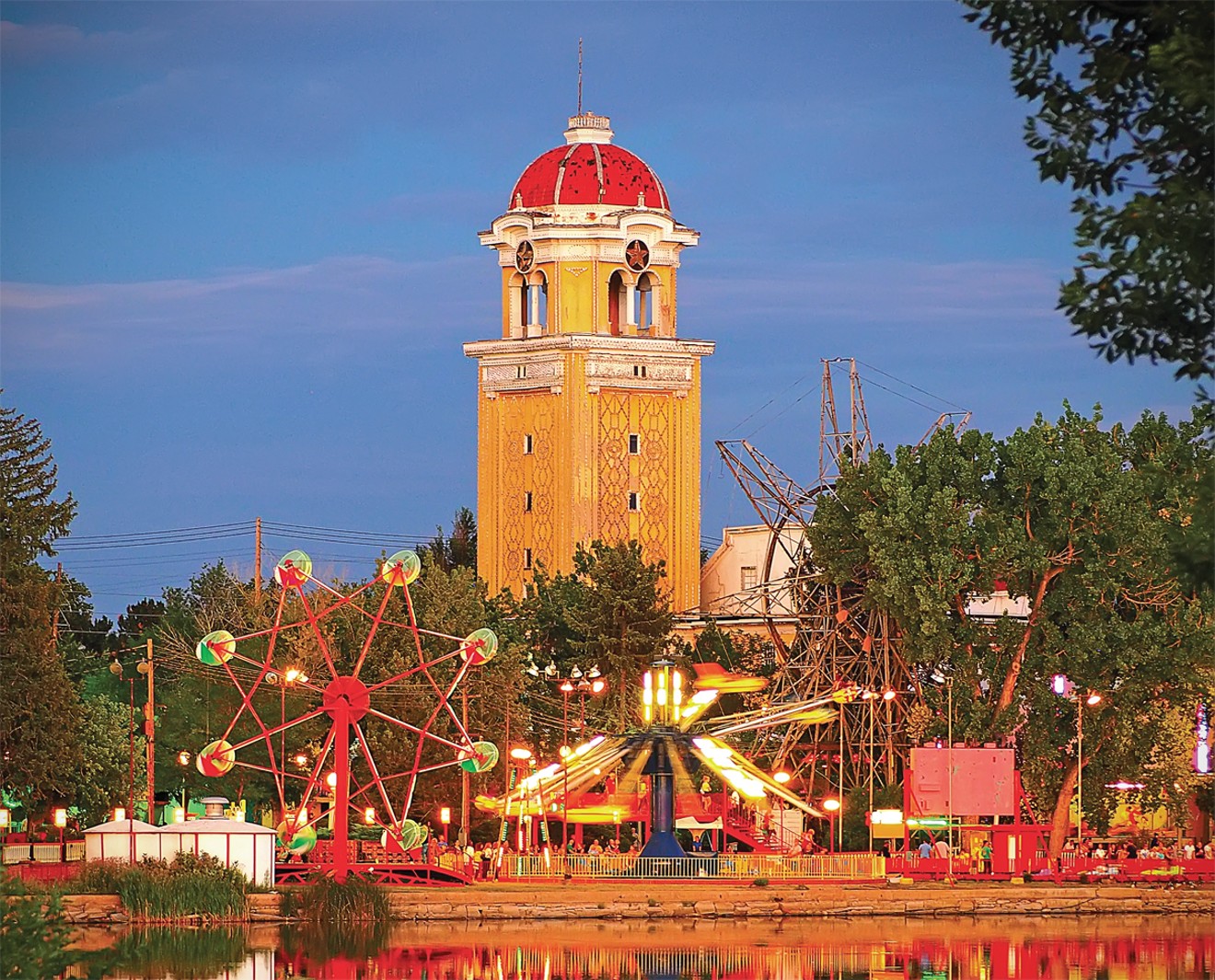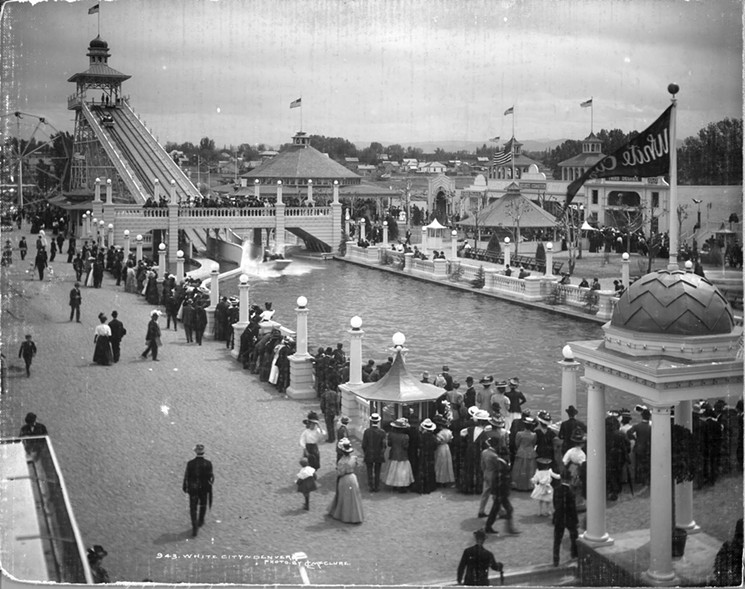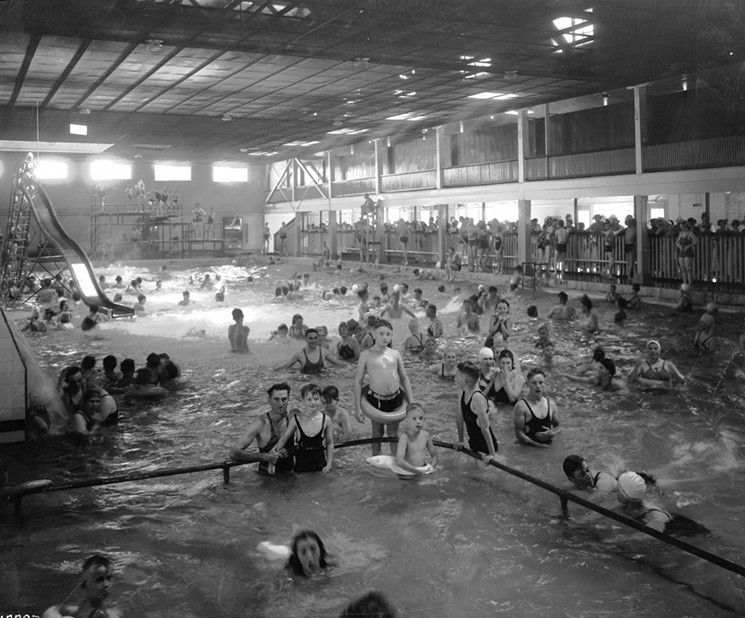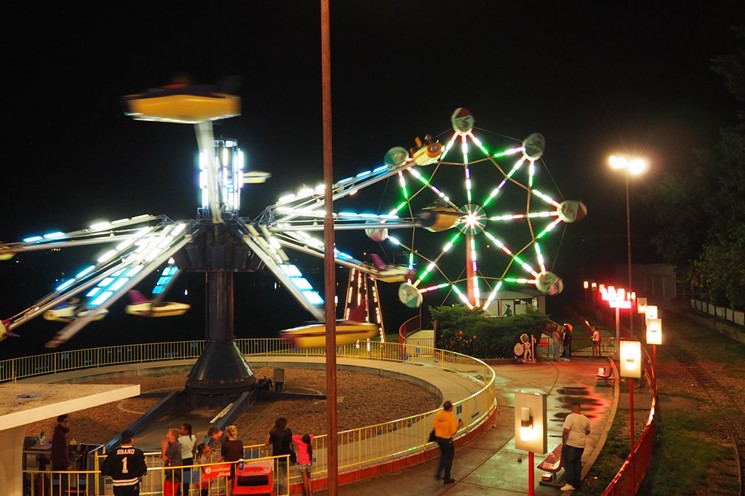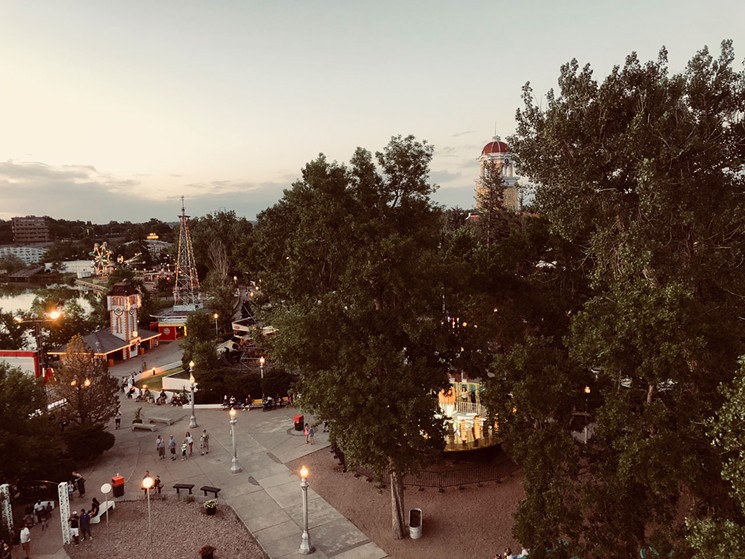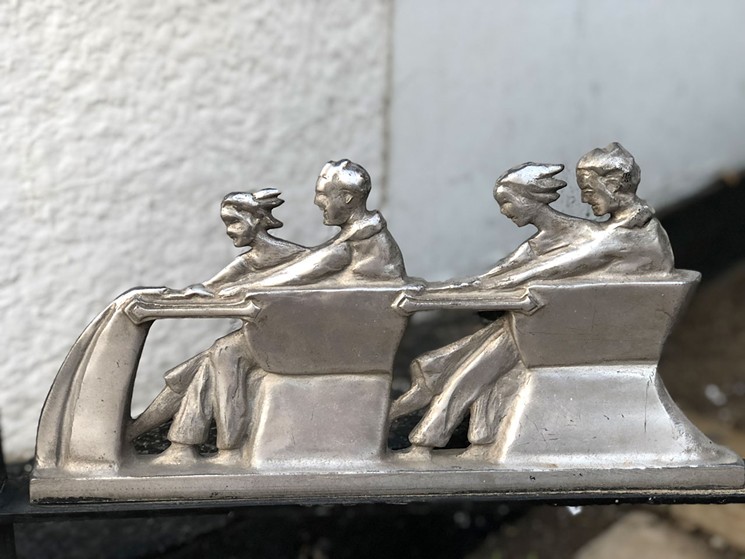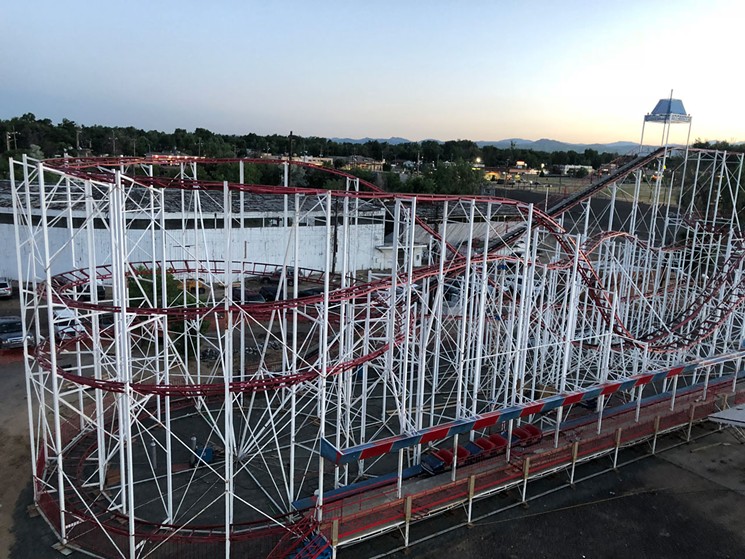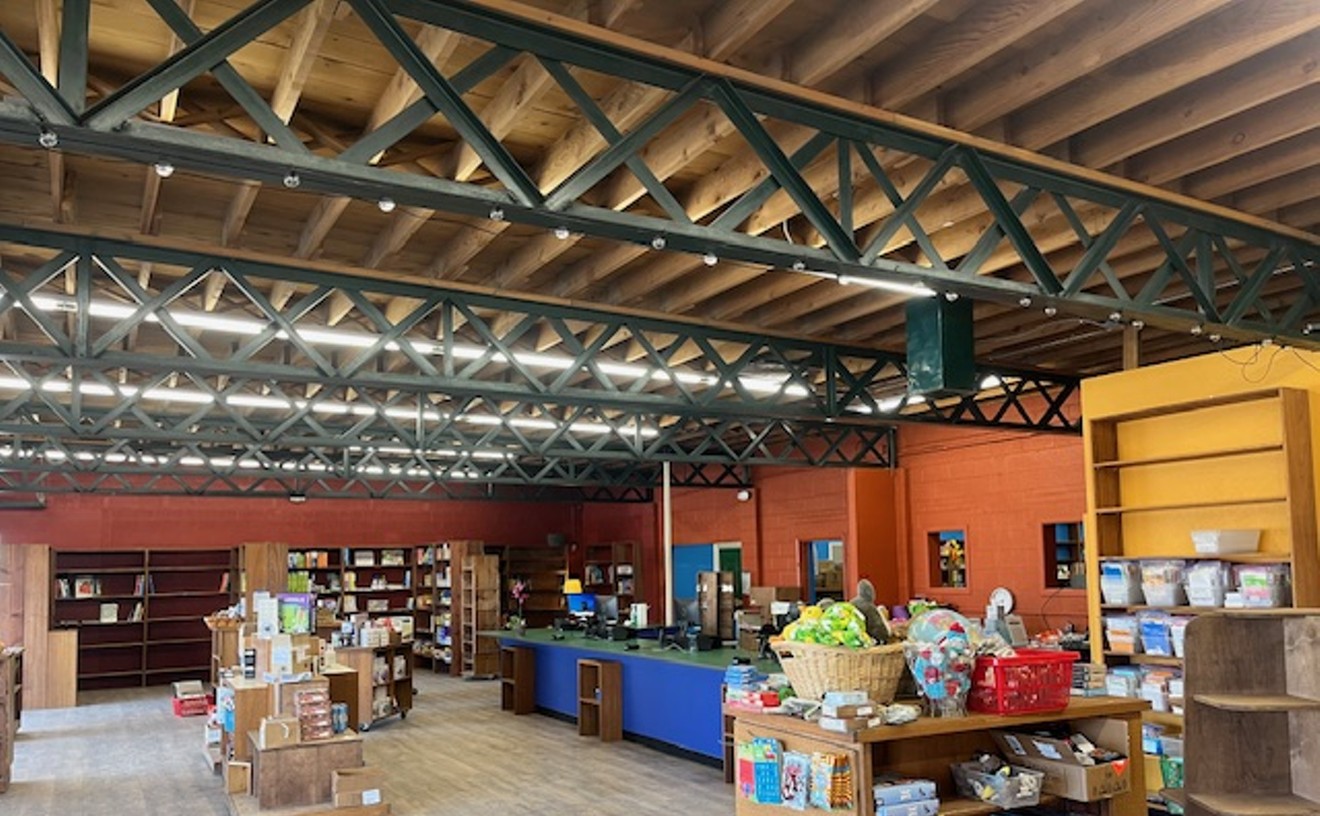For 110 years, Lakeside Amusement Park has been a landmark on the edge of Denver, first as a testament to boosters’ desire to add beauty to the young city, then as one family’s determination to offer affordable family fun to residents of the aging city. It’s a beloved institution that’s made the transition from Beaux Arts grandeur to Art Deco design to what today often looks like nostalgic kitsch. But there are changes in the works. This summer, Lakeside will get its first new ride in years, a Zyklon model steel roller coaster that may well give the classic 1940 wooden Cyclone a run for its money.
Parks were popular in early Denver, with residents often picnicking at cemeteries, in gardens and at early attractions along the South Platte River. Mary and John Elitch took outdoor recreation to the next level when they opened Elitch Gardens, complete with a zoo, gardens and a theater, on West 38th Avenue and Tennyson Street in 1890. But the concept of an amusement park really took off a few years later, with nearly 5,000 amusement parks developed between 1895 and 1910 across the country. Today 400 remain, including Lakeside, the last private amusement park in metropolitan Denver.
“The ideas of both the City Beautiful and the amusement park owed their existence to Chicago’s Columbian Exposition, which an estimated 27 million people from around the world visited between May 1 and October 30, 1893,” David Forsyth writes in his 2016 book, Denver’s Lakeside Amusement Park…From the White City Beautiful to a Century of Fun. The Exposition showcased such “mechanical wonders” as the Ferris wheel, as well as classically styled buildings by architect Daniel Burnham grouped around a central lagoon that “proved that architecture could bring order out of chaos,” Forsyth notes. Frederick Law Olmsted, the landscape architect who’d created New York City’s Central Park, designed the surrounding grounds to add botanical beauty to the overall scheme.
“Nearly everyone involved in the Exposition, from planners to visitors, viewed the Great White City of the Exposition as heavenly, clean, orderly and safe — essentially, everything American cities were supposed to be striving to become,” Forsyth concludes.
Robert Speer, who was elected mayor of Denver in 1904, was certainly inspired by the Exposition when he made the City Beautiful movement a major push. He and brewer Adolph Zang decided to create Lakeside Amusement Park at the edge of Lake Sylvan, at West 46th Avenue and Sheridan Boulevard, to lift Denver from its dirty, bar-brawling roots into a dream city that Speer envisioned as “Paris on the Platte.”
As part of Zang’s master plan, and to avoid Denver’s blue laws prohibiting the sale of liquor on Sundays, the home of the future amusement park was incorporated as the town of Lakeside in 1907, which would allow the brewer-owned facility to serve liquor daily once it opened. Lakeside was truly a company town, and the majority of its 44 initial residents either worked at the amusement park or played a role in its future. Although Zang envisioned the land surrounding the park becoming an upscale housing development, that idea never took hold. The park, however, did.
Lakeside opened in 1908 to much fanfare. An estimated 50,000 people attended opening-day festivities, many of them arriving by the Denver Tramway. The tram let them off at the entrance to the 150-foot-high Tower of Jewels, where they descended a grand staircase flanked by regal lion statues. From there they encountered such wondrous amenities as the Casino, which offered fine dining and shows; the El Patio Ballroom, with 15,000 square feet of floor space, making it a ballroom dancer’s dream; a Music Plaza with a bandstand; a photo studio; a skating rink; a funhouse; a swimming beach complete with diving towers and a boathouse; and the Natatorium, a 50-by-125-foot indoor swimming pool. The park quickly earned the nickname “White City” for the 100,000 white lights that twinkled off the white buildings; 10,000 of them were on the Tower of Jewels (the Denver Republican called it “a pillar of fire at night”), and the rest encircled structures and rides or illuminated pathways. Many visitors were also decked out in white clothing, from large hats on society ladies to white-collared sailor shirts on their well-behaved children.
Lakeside not only had its own police department, but also a hospital and a jail for anyone who got too rambunctious.
For thrill-seekers, the rides were cutting-edge. Many of them nodded to the new age of transportation, with cars, boats, trains and flying machines taking center stage. Shutes-the-Chutes towed a boatful of riders up a slide, then let the boat slide down for a splash landing in the lagoon. The Lakeshore Railway, a miniature steam train, circled the 37-acre Lake Sylvan, showcasing the surrounding Rocky Mountain views; it still runs today, though diesel engines are now used. The Staride, the park’s star-shaped, high-speed Ferris wheel, was not as long-lived, but its structure is visible in a grove of trees, like a futuristic ghost-town icon. The Tickler was described by its inventor, William Mangels, as a ride meant to “jostle, jolt and jounce its riders about in their seats” — but it closed down after its rapid zigs and zags left some riders broken-boned. In contrast, the Velvet Coaster and Scenic Railway both provided gentler roller-coaster options for the faint of heart. The Circle Swing was later updated with stainless-steel rocket-ship cars. And the original Merry-Go-Round, with its menagerie of gaily painted animals galloping to the sound of a live organ, still operates today.
Other passing novelties included pony and burro races, bullfights (no bulls were ever killed), greyhound races and baby incubators that exhibited preemies to help promote medical and public acceptance of Martin Couney’s incubator invention.
In 1935, Ben Krasner, head of concessions at the park, acquired ownership of Lakeside Amusement Park. Rather than the highfalutin’ White City, Krasner envisioned Lakeside as a park for the people. During the Depression and continuing through World War II and beyond, his industriousness, hard work and vision reshaped the park’s image into a family-friendly place.
Most visible were the dramatic changes he made to the look of the park. Working with architect Richard Crowther, Krasner redesigned Lakeside in the Art Deco and Art Moderne styles. Crowther created ticket booths to match the rides, introducing eye-candy colors and dramatic neon lighting. The twinkling lights of White City were soon a faded memory.
Krasner built new boat docks and introduced stylish Chris-Craft motorboats that zipped around the lake, renamed Lake Rhoda in honor of his daughter. The Fun House was reimagined and was now guarded by Laffing Sal, a 6’10” papier-mâché mannequin who laughed uproariously (if scarily for some kids). A new restaurant, the Gayway Inn, was added, with dramatic fluorescent lighting and a grand back bar that Krasner salvaged from Denver’s Union Station. In 1938, he removed a baseball diamond and constructed a 7,000-car parking lot on the southern edge of the park that became increasingly popular as car culture revved up.
Krasner even renovated the enormous swimming pool, adding lights for night swimming. Dennis Gallagher, a lifelong Northsider and political powerhouse in Colorado, recalls: “My grandfather William Gallagher retired from the Rio Grande Railroad. He worked as the boiler tender for the Lakeside swimming pool. He would sneak me into the pool through the boiler room. The Gallagher family probably owes the Krasner family lots in past admissions.”
Above all, Krasner was relentless in his pursuit of thrills, adding new rides at every turn; the Satellite, Auto Scooters, Skoota Boats and the Wild Chipmunk are still fan favorites today. But undoubtedly, the most exciting new draw was the Cyclone, a wooden roller coaster introduced in 1940. It clattered and clunked up 85 feet, then dropped in a heart-stopping rumble, swerving 4,300 feet through a dizzying array of twists and turns. Built by the T.M. Harton Company, the Cyclone is one of only two existing examples of the work of designer Edward Vettel Sr., and one of just a handful of pre-World War II coasters still operating in North America. (In August 2003, the Cyclone was inducted as an ACE Roller Coaster Landmark, a designation reserved for rides of historic significance. The recognition plaque is displayed prominently at the base of the beautifully crafted station, with its marquee entry and a magnificent cast-iron handrail.)
Krasner did more than make physical improvements. He also knew how to give the people more of what they wanted. He capitalized on the park’s position as a premier music venue by booking famous bands led by Tommy Dorsey, Glenn Miller, Duke Ellington, Count Basie and Kay Kyser, competing with rival Elitch Gardens for the biggest names and biggest bands. He promoted Lakeside heavily with newspaper advertising and billboards along Denver roadways that proclaimed, “Denver Has Gone Lakeside.” He embraced the picnic culture with a new pavilion; up to 27,000 guests could eat in style at Lakeside. He courted the media, blue-collar industry and religious and educational institutions in equal measure, hosting annual company picnics and parties that netted positive press. He became a champion of local schools, helping them with fundraisers. Children’s Days included free entry and free ice cream; spectacular fireworks displays punctuated warm summer skies. And he championed the Lakeside Speedway, which hosted daredevil midget and stock-car races for fifty years, from 1938 to 1988.
More than any other move, the Speedway solidified Lakeside’s image as a working-class haven.
That was a sharp contrast to the attractions at the more elite Elitch’s, and there were other major differences between the two. “For years, the division between Lakeside and Elitch’s was not simply a matter that Lakeside was more informal and seemingly scruffier than Elitch’s, but there was also a religious edge,” notes historian and author Phil Goodstein. “In particular, Elitch’s Gurtler family were loyal Catholics who worked closely with Holy Family Parish. It arranged for Holy Family ushers to patrol the dance floor at the Trocadero. They insisted there be no romantic affection shown by those prancing about to the music.
“Lakeside, in contrast, was very much part of the immigrant Jewish experience in show business. The Krasner family had something of a laissez faire attitude on the Moonlight Pavilion of Lakeside — a rival of the Trocadero. The music was seemingly ‘hotter’ there than the desired, sedate Elitch performances. Additionally, Ben Krasner worked extremely closely with Jewish Denver in having celebrations there. Near the beginning of the season, for example, it had a Hebrew School picnic for Lag B’Omer, something of a Jewish rite of spring. Later at the peak of the summer, the B’nai B’rith held its grand picnic there. Included were numerous free ride coupons. The message of Lakeside was to come and have fun — or so adolescent boys came to believe. In contrast, Elitch’s stated come and behave.”
And people did come to Lakeside in droves.

Lakeside has had many ups and downs over the past 110 years, but the Cyclone still thrills riders.
Jay Vollmar
“Two seemingly innocuous incidents at the start of the 1972 season triggered a series of events that threatened the park’s survival,” Forsyth writes. “The Wheat Ridge Fire Protection District, which had long handled fire services for the park, announced that it would not renew fire protection contracts with the park and the town of Lakeside…With no fire protection contract in place, Krasner purchased two fire trucks and asked the Colorado Division of Labor to train Lakeside employees and residents in firefighting techniques.” Concurrent with the withdrawal of fire protection, Forsyth notes, “The neighboring towns of Wheat Ridge and Mountain View, along with Jefferson County, wanted to direct drainage from the road into Lake Rhoda, but Krasner refused, saying the drainage water would kill the lake’s fish and make it harder to run the park’s speedboats.”
Despite these hurdles, Lakeside opened on time for the season. Then on May 14, 1972, there was an accident on the Cyclone. Two train cars collided at a low point on the tracks and four passengers landed in Lutheran Hospital. All injuries were minor, but the incident prompted a series of investigations by the Colorado Division of Labor and the Fireman’s Fund American Insurance Companies, as well as the Jefferson County Fire Safety Committee and two members of the Jefferson County Grand Jury’s fire committee.
“Although the roller coaster accident played a part in prompting the investigation,” Forsyth explains, “the committee members were more disturbed by Wheat Ridge’s failure to renew the fire protection contract. The two investigative committees produced a confidential report they gave to Jefferson County District Attorney Al Herrmann Jr., who in turn told the Denver Post that the report might form the basis for a grand jury investigation of the park.”
It did, and the grand jury investigation continued through 1972 and into 1973. During the investigation, another tragedy added fuel to the flames at Lakeside when Harry’s Club Forty-Four caught fire. The new fire department couldn’t control the blaze, and one of the firefighters died. When the grand jury issued its final report, it cited 65 safety, fire and building-code violations. (Ironically, the most thrilling rides were all deemed safe.)
The report was a blow to Lakeside.
“The grand jury urged the district attorney to do everything possible to prevent the public from entering any of the buildings at the park,” Forsyth writes. “Assistant District Attorney Nolan Brown immediately started legal proceedings to close the park.”
But Krasner was determined to save Lakeside, and made the necessary improvements that allowed the park to continue operating — much to the surprise of the Jeffco DA and other officials.
Change slowed in the ’80s and in the ’90s, when Elitch Gardens built a shiny new facility in the Platte Valley, one with a greater emphasis on family fun and daring thrill rides. Lakeside, meanwhile, began to take on a nostalgic patina, particularly for those who were fans of Art Deco design. Still, Krasner continued to introduce new rides, including the Flying Dutchman and a Frog Hopper in Kiddies Playland. The Zoom, a 140-foot drop tower, was added before the park’s one-hundredth anniversary, raising the thrill level one very large notch.
But the real magic of the 2008 anniversary celebration was that so many of the original rides — the Merry-Go-Round, albeit with recorded music now, the Hurricane, the Satellite and the trains — were still enchanting park visitors.
Gallagher presided over the park’s hundredth-anniversary party. “My happiest memory of Lakeside recalls my beloved daughter, Meaghan Kathleen, who was celebrating her seventeenth birthday and invited friends to ride all the rides,” he remembers. “She often told me when we drove past Lakeside that it was one of the happiest days of her all-too-short life. I remember I rode the train with her around Lake Rhoda and told her ‘Happy birthday’ and that I would always love her.”
Lakeside has weathered more challenges in recent years. It was burdened with unexpected expenses in 2017 when a reckless driver careened into the outside parking structure, collapsing it into a heap. In May of that year, a gigantic hailstorm damaged the Tower of Jewels. “Basically, we’ve got a lot of renovation going on,” Bill Koller, Lakeside’s marketing director, told 9News a year later.
The park continues to spend money for preservation, renovation and innovation. In June, it hosted a Support the Shield fundraiser for the Lakeside Police Department, raising money for protective gear for small forces in Lakeside, Mountain View, Edgewater and others. Lakeside still has its own part-time paid and volunteer fire department, too, but there aren’t as many residents to protect. In the 2010 U.S. Census, Lakeside was Colorado’s smallest municipality, with just eight residents.
But the most powerful spark this summer will be the much-anticipated new roller coaster, whose name and opening date are still tightly under wraps. A Zyklon/Z64 model manufactured by Pinfari in 1973, it was designed to be a roaming coaster that could be disassembled and moved among carnivals, state fairs and amusement parks. So far, it’s done time in Hamel’s Park in Shreveport, Louisiana; at Celebration City in Branson, Missouri; and at the Saginaw County Fairgrounds in Chesaning, Michigan. For the past ten years, it’s been at Fun-Plex Park in Omaha, Nebraska, billed as “The Big Ohhhhh.” According to a 9News report, “There are five other Zyklon models in operation in the United States. One is in Brazil, and two others are for sale for $200,000 apiece.”
More details are elusive; Rhoda Krasner avoids the press. (We were also unable to reach Koller for comments.) Krasner’s daughter, Brenda Fishman, is a physician who’s also involved in the family business, and she says the family still hopes the roller coaster, originally set for a June debut, will start rolling later this summer. “We are continuing work to ensure the ride’s safety and are still awaiting some final inspections,” she says.
Matt Glumac, leader of the Historic Coaster Foundation, applauds Krasner’s preservation of the portable roller coaster in a video post. “The Big Ohhhhh is the perfect coaster for some people that don’t have the courage to ride the Cyclone or even the Wild Chipmunk,” Glumac says. “I think it will boost attendance for the park. It fits really nicely with the park’s old, classic charm. I express my sincere thanks to Rhoda Krasner for saving the Big Ohhhhh. You have done such an incredible job of preserving and maintaining the Cyclone and the Wild Chipmunk, and now you have extended your love of preservation by saving this classic portable coaster for future generations, and I salute you for that.”
Still, preservationists think there’s a lot more to do at Lakeside. The garage destroyed last year is still not completely repaired. More critical, the Tower of Jewels — the only part of the park that was off limits during Ben Krasner’s Art Deco renovation project — is now an aging dowager badly in need of a facelift after being battered by time and weather. So far, though, Rhoda Krasner has resisted having any conversation with outsiders about the Tower of Jewels. “Some people talked of listing Lakeside on the National Register of Historic Places,” Forsyth writes in his book, “but park owner Rhoda Krasner seemed reluctant, preferring to make sure the park remained the family-friendly destination it had been for decades.”
And, new roller coaster aside, the amusement park looks much as it has for decades. Longtime employee Earl has been with the park since 1961; he sits in a wire-caged cashier’s office that seems straight out of a 1930s Frank Capra movie, complete with an old-fashioned telephone switchboard. Earl’s tenure spans four generations of Krasners. “I’ve seen a lot of changes over all these years,” he says.
But while Lakeside may be tattered around the edges, it still thrills and delights throngs of enthusiasts every summer. There’s even a Facebook page, “Remembering Lakeside Amusement Park: 1908-Present,” with over 4,000 members; it’s rich with memories and photographs both past and present.
“What a wonderful family place,” Gallagher concludes. “Bring in your lunch, have a picnic, enjoy the day, no rush here. Not like other amusement parks, the message of which is ‘Pay admission, spend your money and leave.’ Can’t wait to see the new roller coaster at Lakeside and ride the old train and maybe the Merry-Go-Round.”

